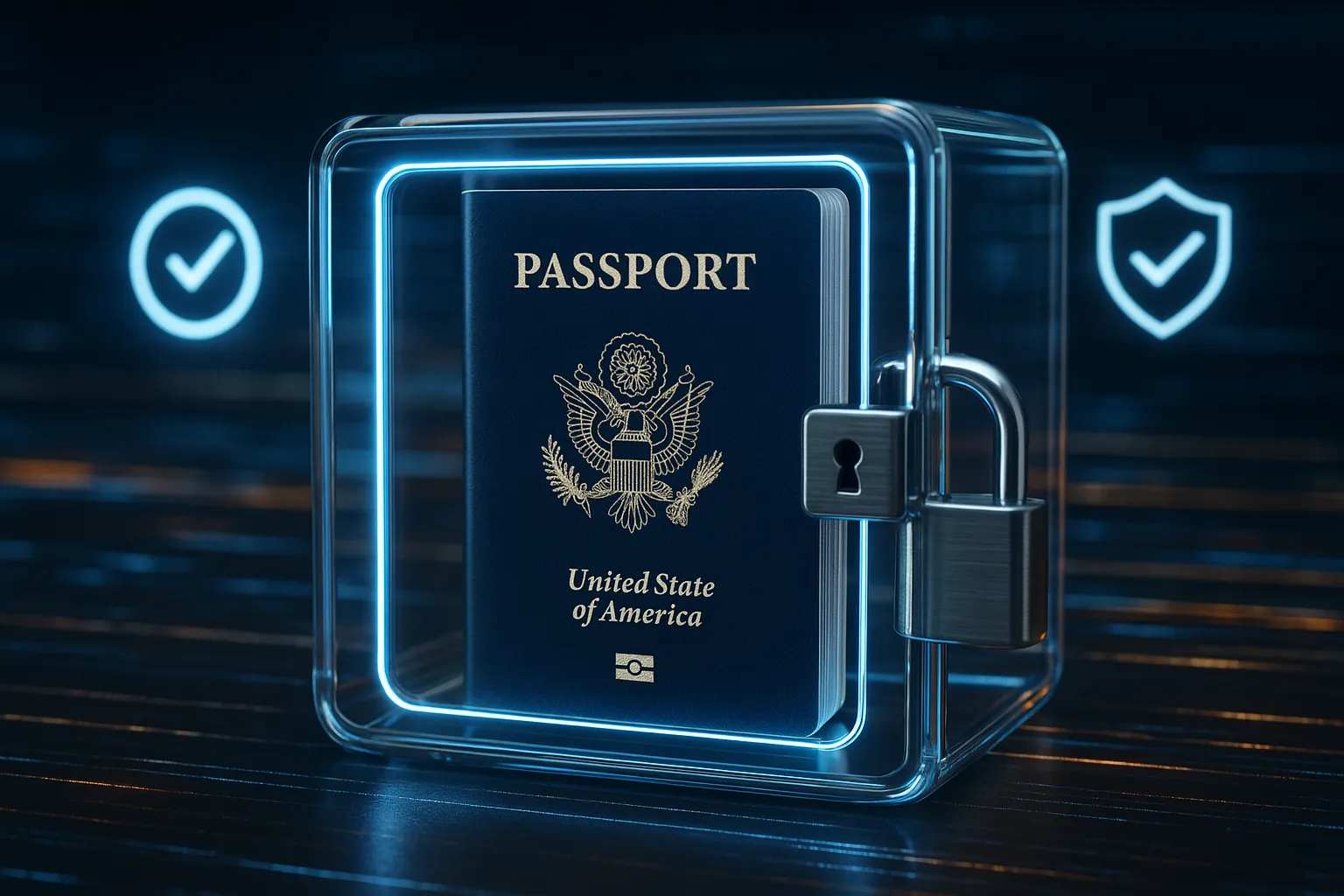Top Compliance Risks When Handling Customer Passport Data

Why passport data is so sensitive
A passport is more than a travel document. Inside the machine-readable zone sit a traveler’s full name, date of birth, nationality, issuing country, and a unique identifier that never changes. Combined, those attributes meet every legal definition of personally identifiable information (PII) and, in many regions, also qualify as “special category data.”
Regulators therefore impose tougher rules on storage, processing and transfer of passport scans than on, say, email addresses. For travel businesses that collect passport details to issue tickets, complete eVisa applications or enable self-check-in, the compliance bar is high—and the penalties for a misstep are higher.
According to IBM’s Cost of a Data Breach 2024 report, the average price tag for a compromised record in the travel sector now stands at US $180 per file. A single PDF of a family’s passports can thus translate into six-figure liability.
In this article we unpack the most common compliance risks companies face when handling customer passport data and outline practical steps to mitigate each of them.
The regulatory landscape at a glance
| Region | Key regulation | Passport data classification | Max financial penalty |
|---|---|---|---|
| European Economic Area | GDPR, Art. 9 (Processing of special categories) | “Special category personal data” | Up to €20 million or 4 % of global turnover |
| United States (selected states) | CCPA/CPRA, NY SHIELD, Colorado Privacy Act | "Sensitive personal information" | Up to US $7,500 per intentional violation |
| Australia | Privacy Act 1988 + APPs | "Sensitive information" | AUD $2.5 million (pending 2025 reforms) |
| Singapore | PDPA | "NRIC & passport number" deemed unique identifiers | SGD $1 million |
| Brazil | LGPD | "Sensitive personal data" | 2 % of revenue in Brazil, max BRL $50 million |
Last updated: August 2025. Always consult local counsel to confirm current thresholds.
Top compliance risks (and how to avoid them)
1. Collecting more data than necessary
Risk: Over-collection violates purpose-limitation clauses in GDPR (Art. 5-1-c) and similar statutes worldwide. A common example is requesting a full passport scan when only the machine-readable zone (MRZ) is needed for an airline’s Advance Passenger Information System (APIS) feed.
Mitigation:
- Map every data field to a documented business purpose.
- When feasible, tokenize or mask extraneous sections—for example, crop the MRZ and discard the rest of the page.
2. Storing passport images indefinitely
Risk: Many booking engines save document uploads “just in case.” Yet most laws require data to be deleted once the original purpose is fulfilled. Keeping archives for years increases breach exposure and attracts fines.
Mitigation:
- Implement automated deletion schedules tied to the date of travel plus a legally justified buffer (e.g., 30 days).
- Use write-once storage with built-in TTL (time-to-live) controls.
3. Unencrypted data at rest or in transit
Risk: Encryption is not optional for special-category data. The 2023 IATA Airline Data Incident Review found that 63 % of leaked passport records were stored in plain PDF form on misconfigured cloud buckets.
Mitigation:
- Enforce AES-256 encryption at rest and TLS 1.3 in transit.
- Rotate keys regularly and apply role-based access via a hardware security module (HSM).
For deeper technical guidance, see our breakdown of visa-system safeguards: How Secure is the Electronic Visa System?
4. Inadequate user consent flows
Risk: Pre-ticked boxes or buried terms do not meet the standard of “freely given, specific, informed and unambiguous” consent. Without valid consent, any downstream processing (e.g., eVisa filing) becomes unlawful.
Mitigation:
- Present a standalone consent checkbox with a concise summary (“We will use this data to submit your Vietnam eVisa and store it until 30 days after your return flight”).
- Log consent details (timestamp, IP, language) and store them alongside the record.
5. Cross-border transfers without proper safeguards
Risk: Emailing a passport scan from an EU head office to a partner DMC in Thailand triggers GDPR Chapter V restrictions. Absence of an adequacy decision or Standard Contractual Clauses can halt operations.
Mitigation:
- Conduct a Transfer Impact Assessment (TIA).
- Deploy regional data residency where possible—for example, process EU passport data inside an ISO 27001-certified Irish data center.
6. Lack of vendor due diligence
Risk: Travel companies often rely on third-party visa processors, ground handlers, or OCR providers. Under most privacy laws, you remain the controller and liable for their mistakes.
Mitigation:
- Perform annual security questionnaires and SOC 2 reviews.
- Include audit rights and breach-notification SLAs (≤72 hours) in contracts.
7. Failure to notify breaches on time
Risk: GDPR gives controllers 72 hours to alert authorities once aware of a breach. Missing the deadline can double penalties and erode brand trust.
Mitigation:
- Build an incident-response playbook with named roles, legal templates, and executive escalation paths.
- Run tabletop exercises twice a year.
8. Shadow copies created by customer support
Risk: Agents often ask travelers to email a passport photo for “verification,” bypassing the secure upload channel. Those attachments linger in personal inboxes or messaging apps.
Mitigation:
- Provide a one-time, expiring upload link integrated into your CRM.
- Disable file retention in chat tools and block outbound email attachments containing MRZ strings via DLP (Data Loss Prevention).
9. Weak identity verification during intake
Risk: If you cannot validate that a passport truly belongs to the customer, you risk facilitating identity theft and violating Know-Your-Customer (KYC) regulations.
Mitigation:
- Layer biometric liveness detection or NFC chip reading into the document-capture flow.
- Cross-check personal details against airline PNR data.
How technology can lower your compliance burden
Manual processes (email attachments, spreadsheets, free-text forms) multiply the above risks. A visa management platform offers built-in controls:
- Field-level encryption & tokenization: prevents over-collection and supports data-minimization principles.
- Event-driven deletion policies: automatically purge files after visa issuance or trip completion.
- Regional data centers: choose EU, US or APAC storage to align with data-residency clauses.
- Audit trails: immutable logs simplify regulatory reporting.
If you are exploring automation, our guide on How eVisa APIs work breaks down the integration steps.

Quick compliance checklist for travel organizations
- Gather only the data required for the service requested.
- Obtain explicit, recorded consent before processing.
- Encrypt passport data everywhere—storage, transit, backups.
- Apply a documented retention schedule and verify deletions.
- Conduct DPIAs (Data Protection Impact Assessments) for new markets or products.
- Vet every third-party vendor with SOC 2 or ISO 27001 evidence.
- Draft and rehearse a 72-hour breach-notification plan.
- Train customer-facing staff on secure document-request workflows.
- Review regional transfer mechanisms (SCCs, BCRs, adequacy) yearly.

The bottom line
Handling passport data is unavoidable in modern travel operations, but non-compliance is not. By understanding the specific risks—over-collection, indefinite storage, weak transfer controls—and deploying the right technical and organizational measures, businesses can protect travelers’ identities and their own balance sheets.
Platforms like SimpleVisa embed these safeguards by design, giving airlines, OTAs and tour operators a compliant path to deliver seamless border-crossing experiences and unlock ancillary revenue—without sleepless nights over the next regulatory audit.
Ready to see how automated visa processing can simplify your compliance posture? Book a demo with our solutions team today.